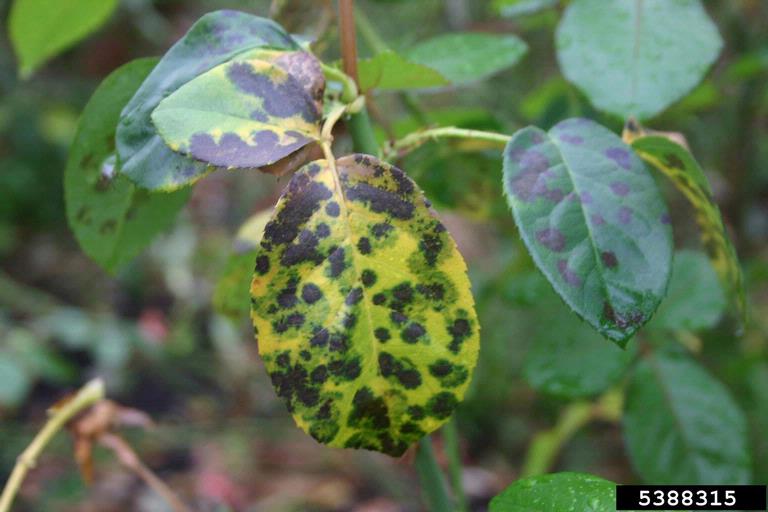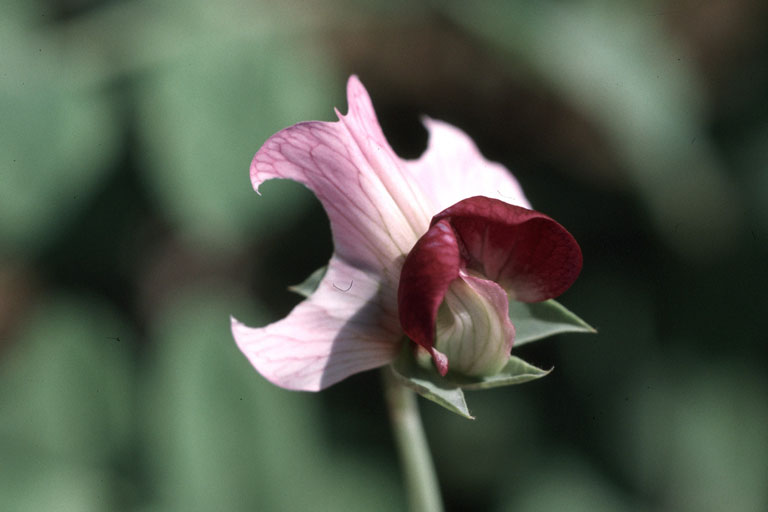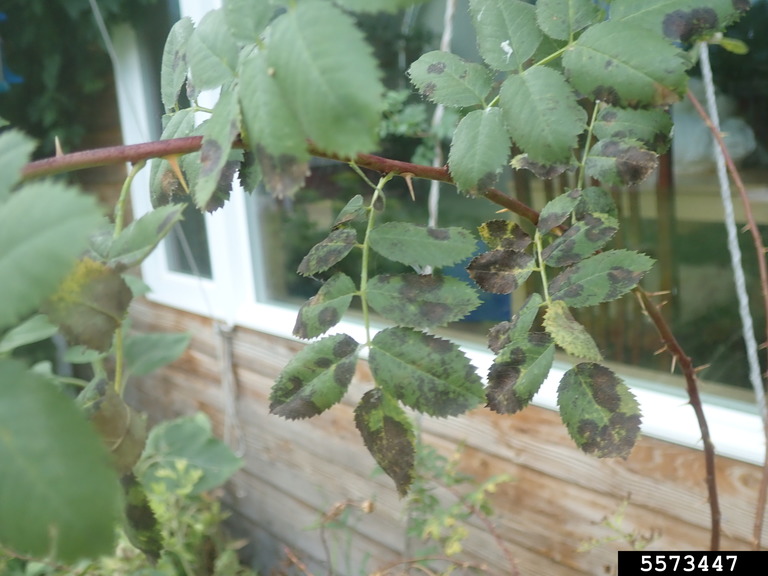
Roses remain one of the most popular ornamental plants for home landscapes, but unfortunately there are several pest problems that affect roses and can reduce the beauty of your plants. Two insect pests commonly found on roses, but usually causing only cosmetic damage, are rose sawfly and leaf cutter bees, but diseases such as rose rosette and black spot can serious affect the health of plants.
 Rose slugs, the immature form of the rose sawfly, have been making an appearance recently in home rose plantings. They are medium to light green in color with an orange head, slightly flattened and about 1/2 inch long. Rose slugs feed at night on the undersides of leaves, beginning with plant tissue between leaf veins. As they grow larger, the insects chew larger holes and skeletonize leaves, causing significant defoliation. There is one generation per year.
Rose slugs, the immature form of the rose sawfly, have been making an appearance recently in home rose plantings. They are medium to light green in color with an orange head, slightly flattened and about 1/2 inch long. Rose slugs feed at night on the undersides of leaves, beginning with plant tissue between leaf veins. As they grow larger, the insects chew larger holes and skeletonize leaves, causing significant defoliation. There is one generation per year.
Wash insects off with water or hand-pick them. If many plants are affected, several insecticides will provide control, including bifenthrin, carbaryl, permethrin or spinosad. Thoroughly cover the upper and lower leaf surfaces for best control. However, avoid spraying the rose flowers to prevent damage to bees. Right - image of a bristly roseslug, from Whitney Cranshaw, Colorado State University, Bugwood.org.
 Leafcutter bees are an important native pollinator. They are solitary and not aggressive, similar in size to honeybees, and black, metallic purple or green in color. Females nest in soft, rotted wood or in the stems of large, pithy plants. They line their nests with small circular segments cut from the edges of rose leaves or petals; they do not eat the leaf segments. Damage to roses by leafcutter bees is a curiosity and is of little significance to plant health. No control is recommended. Left - image of leafcutter bee damage, from Whitney Cranshaw, Colorado State University, Bugwood.org.
Leafcutter bees are an important native pollinator. They are solitary and not aggressive, similar in size to honeybees, and black, metallic purple or green in color. Females nest in soft, rotted wood or in the stems of large, pithy plants. They line their nests with small circular segments cut from the edges of rose leaves or petals; they do not eat the leaf segments. Damage to roses by leafcutter bees is a curiosity and is of little significance to plant health. No control is recommended. Left - image of leafcutter bee damage, from Whitney Cranshaw, Colorado State University, Bugwood.org.
 Rose rosette is thought to be caused by a virus-like organism transmitted by a mite. Infected leaves are deformed, wrinkled and bright red in color. Blossoms often are aborted, deformed, or converted to leaf-like tissue. Stem may rapidly elongate, with some stems later becoming thickened and very thorny. Witches' brooms also may develop, with clusters of short, thorny branches. Infected plants usually die within two years as symptoms spread throughout the plant. No chemical control is available for rose rosette; infected plants should be removed. Right - rose rosette symptoms on 'Iceberg' rose including abnormally elongated stems and excess pricles. Image by Jennifer Olson, Oklahoma State University, Bugwood.org.
Rose rosette is thought to be caused by a virus-like organism transmitted by a mite. Infected leaves are deformed, wrinkled and bright red in color. Blossoms often are aborted, deformed, or converted to leaf-like tissue. Stem may rapidly elongate, with some stems later becoming thickened and very thorny. Witches' brooms also may develop, with clusters of short, thorny branches. Infected plants usually die within two years as symptoms spread throughout the plant. No chemical control is available for rose rosette; infected plants should be removed. Right - rose rosette symptoms on 'Iceberg' rose including abnormally elongated stems and excess pricles. Image by Jennifer Olson, Oklahoma State University, Bugwood.org.
 Black spot is by far the most troublesome disease of roses in Nebraska, causing circular black lesions surrounded by yellowing leaf tissue. Lower leaves are usually the first to be infected, followed by the middle and upper leaves. Heavily infected leaves drop from the plant. A high percentage of defoliation weakens plants, decreases the vigor of their growth, and makes them susceptible to winter injury. Right - image of black spot lesions on rose leaves, from Whitney Cranshaw, Colorado State University, Bugwood.org.
Black spot is by far the most troublesome disease of roses in Nebraska, causing circular black lesions surrounded by yellowing leaf tissue. Lower leaves are usually the first to be infected, followed by the middle and upper leaves. Heavily infected leaves drop from the plant. A high percentage of defoliation weakens plants, decreases the vigor of their growth, and makes them susceptible to winter injury. Right - image of black spot lesions on rose leaves, from Whitney Cranshaw, Colorado State University, Bugwood.org.
The fungus survives as mycelia on the host plant, in fallen leaves or in infected canes throughout the year. Infection begins through rain splash of spores from infected plant parts or from the soil unto the lowest leaves of the plant. Temperatures between 75° - 85°F are favorable for disease development, along with relative humidity above 85%, with six or more hours of leaf wetness.
On plants with a history of infection, remove last year's mulch and replace it with fresh mulch to minimize disease pressure. Prune plants to allow for good air circulation. Keep foliage dry by not watering overhead. Heavily affected plants should be treated weekly with a fungicide spray, or treated with a systemic fungicide according to label directions. Or replace highly susceptible plants with those that are black spot resistant.